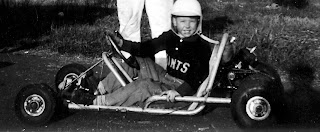We keep an identification and performance record book of our
cows in the pick-up at all times and we refer to it daily when checking cattle.
We would be lost without it.
When we buy new cows, they are usually freeze branded with letters and numbers on their hips telling us their birth year. The also have a corresponding ear tag, but often they lose these tags and the brands fade. So while they go through our chute and have our own brand
put on them, I write a little color description of each girl in the book: black, red,
baldy, or brockle.
In a herd of 400-500 cows, however, there are many who look the same and further physical details are needed for identification. For instance cow T680 is black with white on the
left side of her bag or Y390 has one black eye and some white on her tail tip. At this early stage of the game these are the only details known and their slates
are pretty clean; no personality or production disorders are known or written yet.
When they give birth for us the first time we write down
the date and a description of each calf. If the cows are healthy and
productive, we usually keep them until they’re 10 years old. In this time some
of their records become blotted. They may have bad hoofs or legs, an eye
problem, a knot on the neck. Having trouble
calving unaided, having a bad udder, or not enough milk will send her to the
sale barn pretty quickly on the Wright Ranch.
Personality characteristics become part of the record too. One may be a wanderer, always climbing through a fence to greener pastures and requiring more than a single wire electric fence. She might be very protective of a new calf or turn mean when she’s penned and needs to be watched. A few are tree hiders. We’ve had some cows who leave the herd two weeks before calving, hiding until the calf is several days old and costing us lots of time looking for her and wondering if she's dead.
Some good traits are recognized also: gentle,
good mother, lots of milk, will take an orphaned calf if necessary, chow dog (first
to the horn and the protein pellets!)
The culling gets harder when she just gets old, but has
caused us no problems yet. This year some old favorites went to the sale barn. P101 had a spotless record, was gentle,
raised good calves and would let you touch her nose. M313 calved twins alone twice and raised them
herself nicely. N80 was a big black
beauty.
We’re not horse people anymore so in the fall we drive
the herds to the Wilson portable corrals with our 4-wheelers, push the calves back
out into the pasture, then begin sorting
the cows on foot.
I don’t get in the
pens with them very often any more because I can’t climb the fence fast enough
if something goes wrong! So I stay on
the outside with the cull lists I’ve made from the book ahead of time for each
group. The guys sort off the ones I tell
them need to be culled and whose calves are old enough to wean. We load the cull cows and haul them to the
sale barn.
I thought a lot
about our culling criteria this year and how I fit the description myself. Bad knees,
not tall enough, only produced one live offspring, not content with the same feed every day, not very herd-bound, tends to enjoy being alone more than most, likes to explore and travel, resists being driven, irritable when confined...
I’m sure glad God’s culling standard isn’t based on looks,
health, performance, or personality!
What a blessing to know that Jesus’ blood continues to wipe my record
clean and the only criteria for entering heaven and staying in His herd will be
that I loved and obeyed Him.
For God has not destined us for wrath, but
for obtaining salvation
through our Lord Jesus Christ,
Who died for us, so that whether we are awake
or asleep,
we will live together with Him.



























